Are you asking, What are strategic communications? If so, ask yourself if your internal communications are successful. These 100% free ideas can help you.

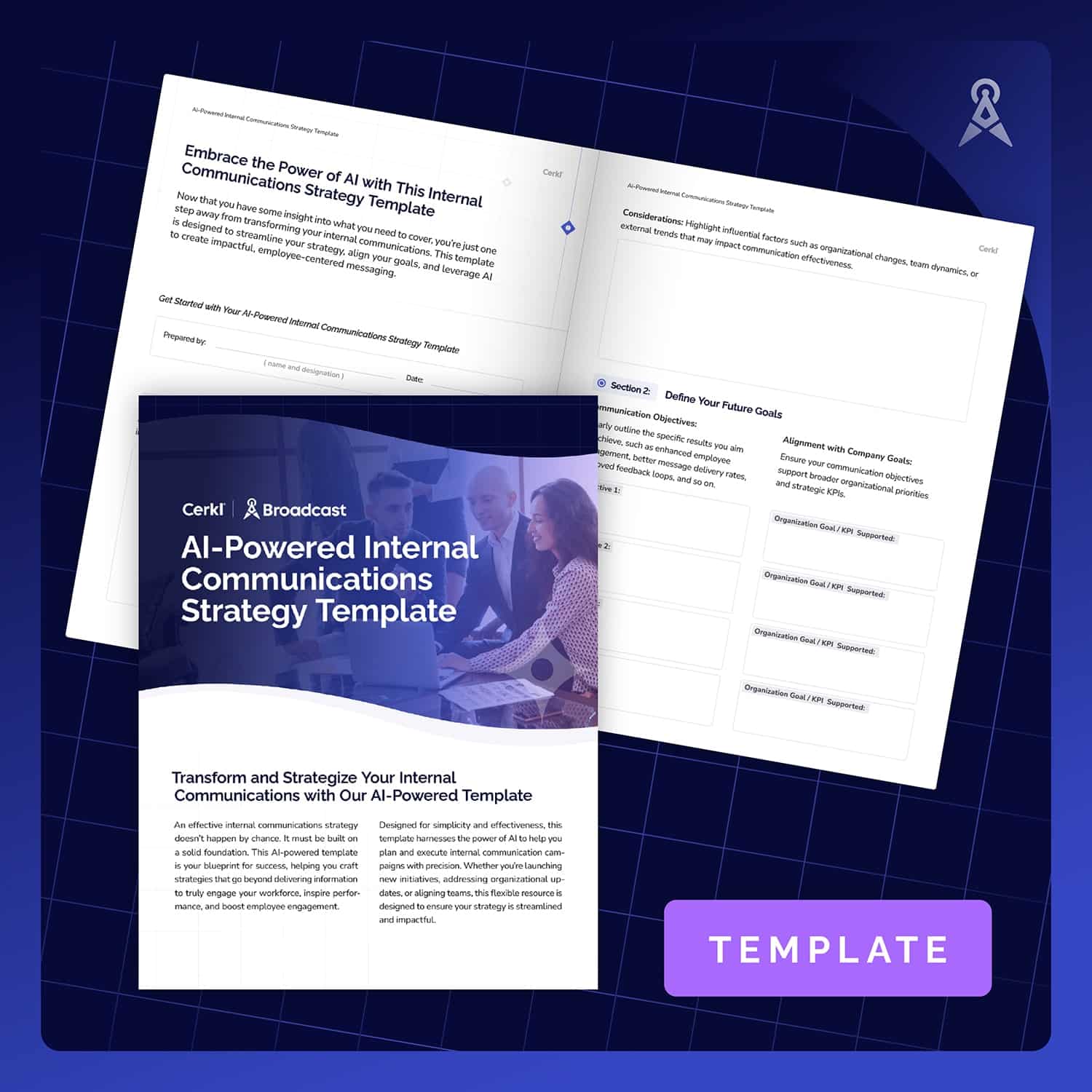
Start strategizing smarter. Download your free AI-driven internal communications strategy template now!
Access NowStrategic communications involve the intentional planning and delivery of focused messages to achieve particular goals and shape desired perceptions within a specific audience, in this context, employees. The question is, Are you meeting the strategic communication goals set for your organization?
We will examine this question and consider why strategic communications are so important.
According to Gallagher’s State of the Sector 2023/24 report, the primary purpose of internal communication is, according to 86% of respondents, strategic alignment. That’s no surprise since Gallagher’s previous State of the Sector report identified that 77-78% had reported strategic alignment as their purpose. However, 82% stated that their internal comms department identified culture and belonging as their purpose.
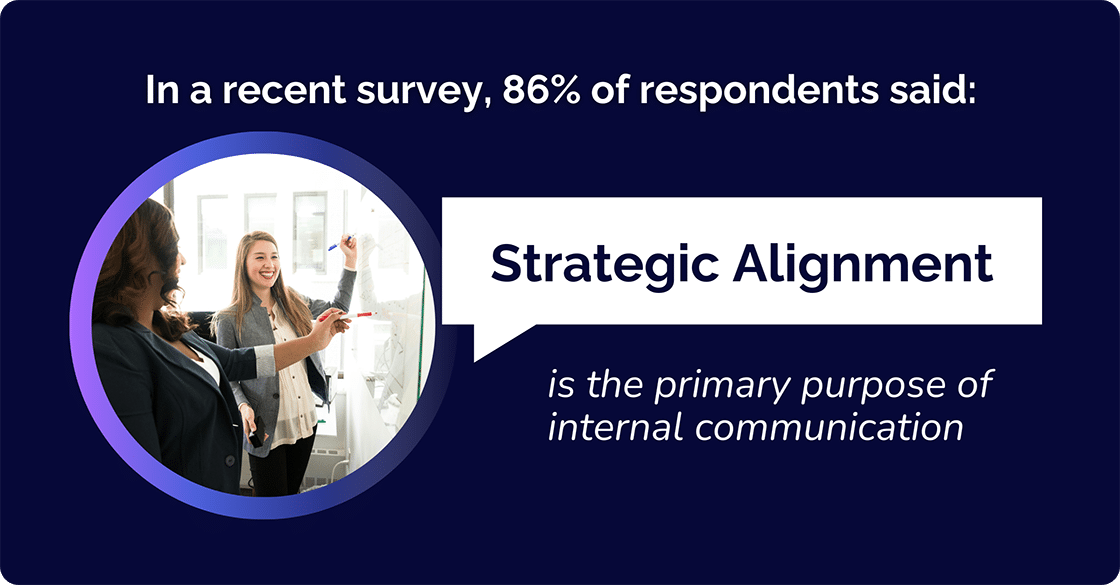
Other “success indicators” that communicators are held accountable for include employee engagement (74%) and strategy awareness (70%).
At the same time, Gallagher found that “the same old organizational barriers persist.”
In a June 2024 article, The need for strategic alignment between internal communications and business strategy, Gallagher Employee Experience Strategy Lead, Sharn Kleiss, states that internal comms and business strategy should be symbiotic.
He explains that internal communicators have a unique bird’s-eye view of the business, understanding employee needs and sentiments. This enables tailored, strategic messaging that resonates. With the right metrics, you can track and demonstrate communication’s impact on engagement and performance, strengthening your influence in leadership discussions.
Beyond this, partnering across departments — HR, IT, finance, and operations — aligns internal comms with broader business goals. Collaboration drives cohesive, integrating strategies that support the organization’s overall direction.
Ultimately, communication is essential to human interaction. No matter the context, it’s not just about the information you share but ensuring your message is heard, understood, and acted upon. Without a clear and concise communication strategy, even the best intentions and messages can fall flat and make zero difference to anyone.
We will start by discussing strategic communications. Then, we will explore the importance of a strategic communications plan, best practices for strategic communications, and how to implement a strategic communications strategy in your organization.
Harness the power of AI to devise a strategy that will be a game-changer for your organization.
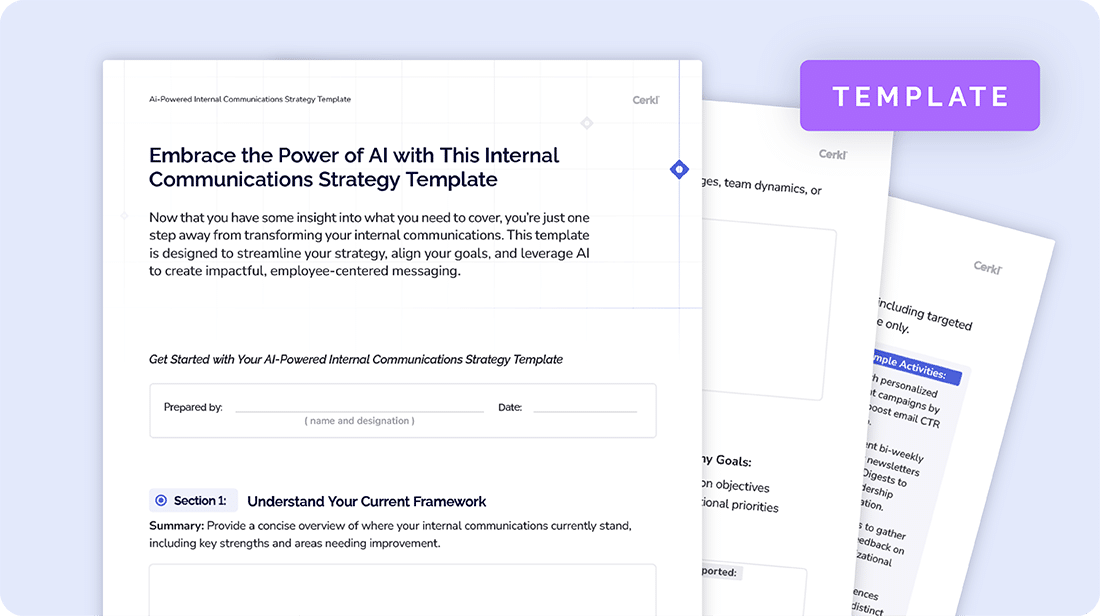
At first, strategic communications may seem like an impossible concept to implement and achieve. It is, after all, a broad term that may be perceived and applied in many different contexts. However, it can also be narrowed down into a concrete definition for internal communicators to garner and act upon.
In essence, strategic communications represent the basis of how people communicate with their audiences. This includes many different elements that focus on an organization’s conscious use of communication to fulfill its mission.
Effective strategic communications go beyond simply delivering messages. They ensure harmony between organizational goals and audience needs. By being intentional and targeted, internal communicators can shape perceptions, drive engagement, and support business objectives through clear, purposeful communication.
According to the University of Technology Sydney (UTS), a global online university headquartered in Australia, strategic communication is "the messaging that businesses and organizations use to work towards achieving their mission." It involves "the careful design, implementation, and evaluation of communication methods as part of an overall strategy, which focuses on results rather than on specific tactics."
This definition emphasizes the intentional planning and execution of communication efforts to align with an organization's goals and objectives.
This means that it needs to be overarching, and ongoing, providing a vital direction. An internal communication plan, on the other hand, is time-bound and exists within the context of a strategy. At the same time, a communication process is part of a communication plan.
As internal communicators, you are using these tactics to focus on employee engagement and communication. Strategic communications raise the value of communication by tying it to the goals and results of the business.
A strategic communication plan is a tactical tool internal communicators, HR professionals, and other related professional fields use to support the organization’s much more comprehensive strategic framework. It relies on a step-by-step process that will lead communicators toward a concrete goal. It operates within the broader framework of the organization’s all-encompassing strategy.
Here’s an example of a strategic plan vs an all-embracing communication strategy.
A business needs to be producing content that is interesting and also hits the mark in terms of engagement within corporate communication developed to inform and motivate employees. To be able to write stories that are interesting and that generate new ideas, this is what we can do:
Strategic communications encompass both internal and external messaging, each playing a crucial role in organizational success.
Internal communicators must ensure that both messaging types work in harmony. A well-aligned communication strategy ensures consistency, preventing discrepancies between what is communicated internally and how the organization is perceived externally. Clear, transparent, and purpose-driven messaging strengthens trust, engagement, and overall effectiveness.
Harness the power of AI to devise a strategy that will be a game-changer for your organization.

The ultimate aim or goal of strategic communications is to deliberately plan and convey messages. But it needs to be done in a way that achieves specific objectives, shapes perceptions, and fosters desired outcomes among a targeted audience. It also needs to support organizational goals and initiatives. Strategic communications aim to create a cohesive and effective communication strategy that will achieve measurable and meaningful results.
Here’s how you can achieve your strategic communications goals.
Ensure that your communication efforts closely align with your overall organizational objectives. This will help to create a unified and purposeful messaging strategy, enhancing the effectiveness of communication campaigns.
The Gallagher report referred to above found that creating strategic alignments is one of the main purposes of internal communications — and its value keeps rising.
Strategic communications should focus on consistently portraying a positive image and proactively addressing potential challenges. This can contribute to building and sustaining a strong organizational reputation over time.
Establish meaningful connections with the target audience through interactive and tailored communication channels. This will foster engagement, loyalty, and a deeper understanding of your audience’s needs and preferences.
A well-prepared communication strategy for crises involves timely, transparent, and empathetic messaging. You need this to manage the situation effectively, mitigate reputational damage, and rebuild trust.
Strategic communications play a vital role in conveying the rationale, benefits, and details of organizational change initiatives. To drive change successfully, you need to foster understanding and gain employee and stakeholder support.
Increase your organization’s visibility through strategic communication channels and activities. The goal is to help broaden its reach, attract attention, and reinforce key messages for greater impact.
Craft messages that shape how the organization is perceived by its audience. This will help to create a positive image that will influence stakeholder attitudes and behavior towards the organization.
Provide clear and relevant information via strategic communications to help stakeholders make informed decisions. This will also promote a sense of confidence and trust in the organization.
By maintaining a consistent tone, messaging, and branding across various communication channels you can help to build a cohesive and recognizable organizational identity, reinforcing key values and attributes.
Implementing robust measurement tools and analytics will allow your organization to assess the effectiveness of communication efforts. It will also help you to make data-driven adjustments and demonstrate the impact of strategic communications that relate directly to organizational goals.
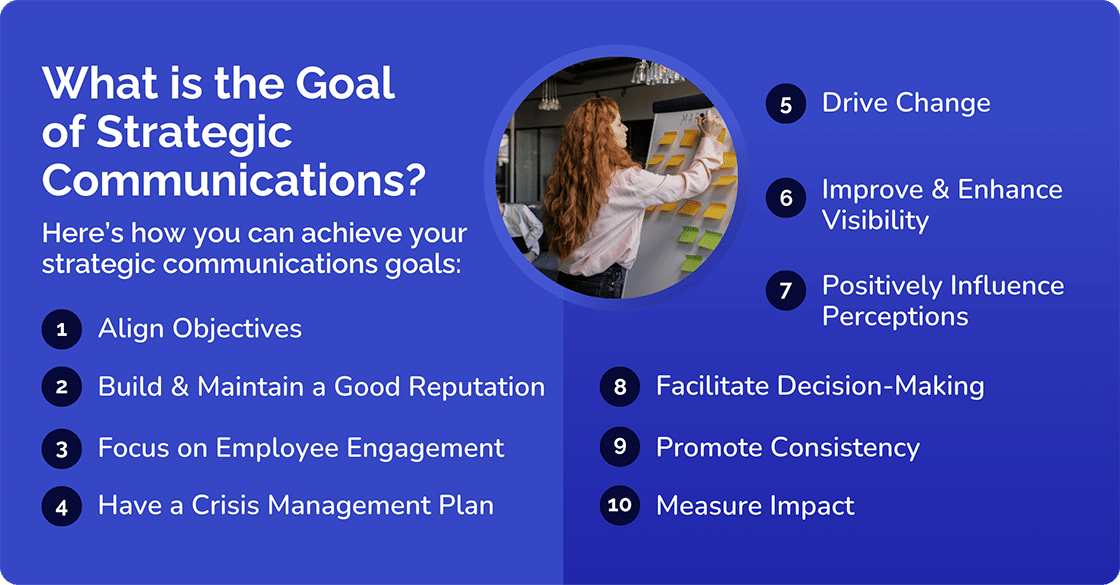
Strategic communications are crucial because they align messaging with organizational goals. They also shape perceptions and foster meaningful connections, ultimately contributing to the achievement of desired outcomes and long-term business success.
Employers often exhibit their corporate values through their behavior without even realizing it. This is why incorporating corporate identity into strategic communication is highly beneficial.
By developing strong organizational communication, a company can help employees internalize their core values. These employees will be able to transfer those values into attitudes and behaviors.
Customer interaction can make employees’ attitudes and behaviors count. In this emerging “experience economy”, the consumer is a guest who wants a personal and memorable employee experience. If corporate communication communicates those values, then your employees will internalize them and reflect them to customers.
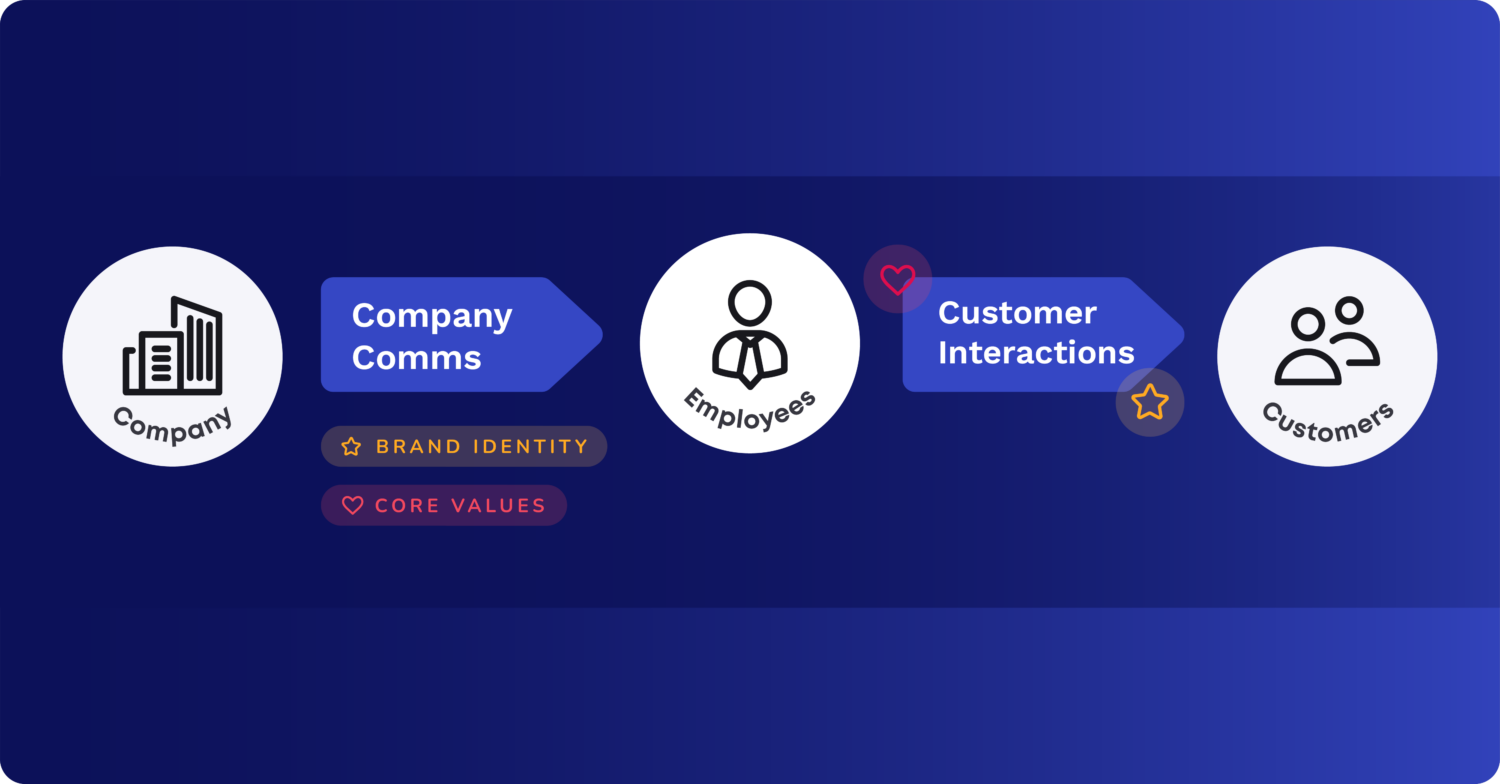
Company corporate communication transfers a company identity to employees resulting in better customer interactions.
Merging company culture and organizational communication is another incredibly useful strategy. However, Gallup maintains that only two in 10 US employees feel connected to their company’s culture.
The key lies largely in successful employee engagement. One of the major issues is that leadership doesn’t often communicate the organization’s intended cultural values and strategy clearly in the new world of work.
“Simply put, when your organizational culture is wrong, employees — and customers — leave. Organizational culture aligns your workforce and points it at the outcomes that matter most to you, ensuring everyone is pulling in the same direction.” Gallup
However, when you get it right, Gallup points out that you will attract and retain better employees. This, in turn, will increase employee engagement and productivity. It will also improve employee wellbeing and safety, and enhance diversity, equality, and inclusion. Ultimately, this approach will enable you to deliver the best possible customer experience.
A 2024 report by ScreenCloud highlighted that only 23% of employees globally felt engaged at work, emphasizing the need for intentional communication strategies to boost engagement and cultivate a positive company culture.
“The bad news is, stress is at an all-time high, employees are increasingly disconnected from their company’s culture, and less than one-fourth of the workforce feels adequately recognized for their work or plans to stay with their company long-term.” ScreenCloud
Stakeholder engagement in strategic communication refers to the process of involving and interacting with individuals, groups, or entities that have an interest or influence in an organization’s activities.
Building trust within this engagement is essential, as it involves consistently delivering transparent, credible, and authentic messages that align with stakeholders’ expectations, needs, and values. Trust, established through open communication and demonstrated reliability, fosters stronger relationships, enhances organizational credibility, and contributes to the overall success of strategic communication initiatives.
It stands to reason that it can help more than anything to have a competitive advantage in business.
A competitive example in strategic communications could involve a company distinguishing itself from competitors by crafting a unique and compelling brand narrative that resonates with its target audience. This might include leveraging innovative strategic communication channels like social media campaigns or interactive content to create a distinct and memorable brand identity. By effectively differentiating itself in the marketplace through strategic messaging and engagement, the company can gain a competitive edge and build a stronger connection with its audience.
The importance of adapting to change in strategic communications relates directly to the ability of an organization to flexibly adjust its messaging and strategic communication approach in response to evolving circumstances, industry trends, or unforeseen events. It involves staying agile and responsive to shifting audience preferences, technological advancements, and external influences. This way business leaders can ensure that communication efforts remain relevant, effective, and aligned with organizational communication and the overall goals of the company.
By embracing adaptable, strategic communication, leadership can proactively navigate challenges, seize opportunities, and maintain an effective resonance in an ever-changing landscape.

When you implement strategic communications within a company, this doesn’t mean churning out tons of content just for the sake of surface-level communication. There is a critical need for attention to detail and deep thinking, which positively affects your employees.
Employees generally want to feel connected to the organization they work for. One way to meet this need is through purposeful leadership communication and a good strategic communication plan. Here are some suggestions:
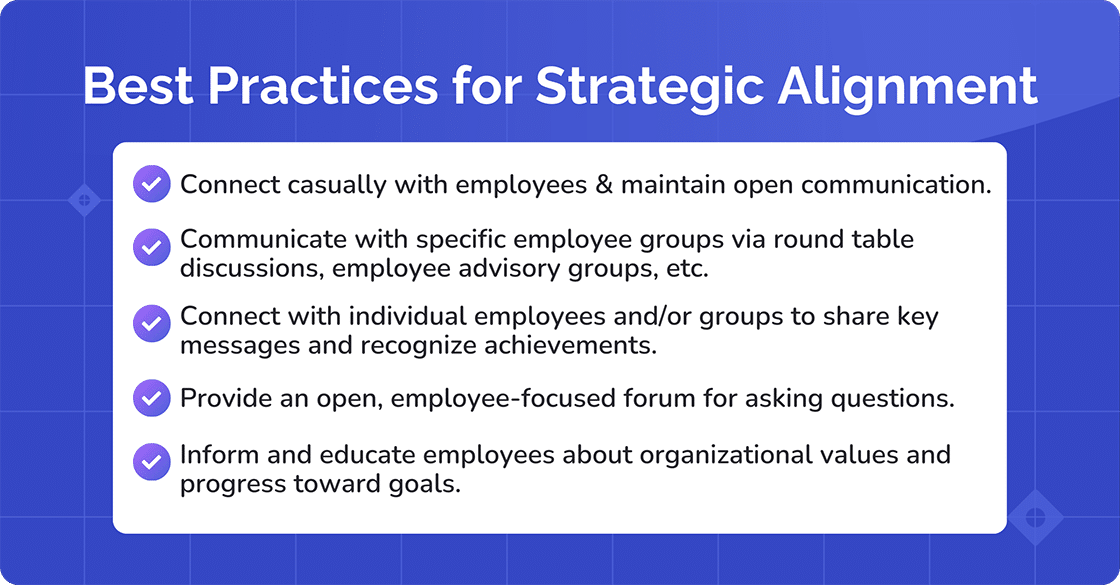
Strategic communications make a large impact on employees’ relationships within any organization. The strategy is what internal communicators come back to when they make a decision or send out a corporate communication. The specific parts of it — good company culture and corporate identity and strengthen the bond between employees and the company in most cases.
Using the right tools is essential for delivering clear, consistent, and engaging strategic communications. Whether you’re reaching employees, stakeholders, or customers, leveraging digital platforms ensures your messages are timely and impactful. Two of the most effective tools are email and newsletters, which help streamline communication and reinforce key messages.
Email remains a cornerstone of internal and external communication due to its immediacy, accessibility, and ability to reach large audiences. A well-crafted email strategy ensures that important updates, leadership messages, and time-sensitive information are efficiently delivered. Internal communicators can use targeted email campaigns to personalize messages, segment audiences, and track engagement metrics for continuous improvement.
Newsletters provide a structured way to share company updates, highlight achievements, and reinforce organizational culture. Whether weekly, biweekly, or monthly, newsletters help internal communicators maintain transparency and keep employees informed. When integrated with analytics, they become a valuable tool for measuring engagement and identifying content that resonates with different audience segments.
A successful strategic communication plan requires a structured, personalized approach that aligns with your organization’s goals. Key steps include:
Cerkl Broadcast is a powerful platform designed to suit the needs of any size organization, regardless of its structure. Ideal for internal communicators, it serves as a centralized hub for all types of communication. When developing a strategic communication strategy, you can rely on Broadcast for effective planning that makes the end result more effective and manageable.
Cerkl Broadcast enables internal communicators to automate, personalize, and optimize messaging for maximum impact.
By integrating personalization into your strategic communication plan with Cerkl Broadcast, you can create more meaningful, engaging, and effective communication that aligns with employee needs and business goals.
https://www.youtube.com/watch?v=0QNSbGwK_MM
Tarek Kamil, Cerkl CEO, offers insights from a recent conference on Strategic Internal Communications
Not sure what to do next? We recognize that many internal communicators may be feeling overwhelmed. For this reason, we have created an AI-powered internal communications strategy template for people like you. And it ‘s absolutely free.
We also provide guidelines that will help you assess where your internal communications program is now as well as what you want to achieve. We suggest ways that you can reach your goals, together with ways you will know if your efforts succeed… together with a lot more tips for a successful strategy.
Embrace the power of AI with our free template.

Harness the power of AI to devise a strategy that will be a game-changer for your organization.
What is strategic communications? Strategic communications are the result of a planned, coordinated approach to conveying and sharing information. It’s used when specific outcomes are required and is commonly used for internal communications within a broad range of organizations.
What are examples of strategic communications? There are many reasons for developing strategic communications plans. For example, they are great for reinforcing corporate identity, establishing a company culture, corporate branding, and crisis management.
What do strategic communicators do? Strategic communicators plan, develop, and execute communication strategies to achieve specific goals.
What is a strategic communications plan? A strategic communications plan serves as a roadmap for organizations to navigate and optimize their communication efforts. It is a structured document that outlines goals, target audiences, key messages, and various coordinated activities designed to effectively convey information and achieve specific objectives. It also maintains consistency and adaptability in response to various communication needs and challenges.

Harness the power of AI to devise a strategy that will be a game-changer for your organization.